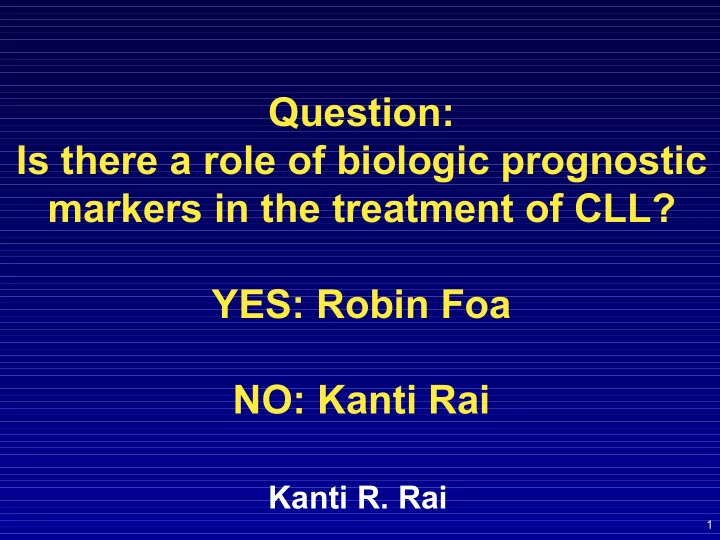

Question: Is there a role of biologic prognostic markers in the treatment of CLL? YES: Robin Foa NO: Kanti Rai Kanti R. Rai 1 1
Relevant References • Hallek et al, Blood 2008, New Guidelines. • Weidra et al, JCO 2009, Beta-2, Age • Grever et al, JCO 2007, FC vs F • Shanafelt et al, Blood 2004, Need to develop model • Montserrat, Blood 2006, Refractory CLL • Gribben, Blood 2010, Follow IWCLL • Orlandi et al, Haematologica 2009; 94:S46. 2 2
Biological Prognostic Markers • FISH Cytogenetics • IGHV Mutation Status • Zap-70 Status • CD-38 Status 3 3
FISH FISH Cytogenetics enable us to divide CLL patients into three risk categories: RISK CATEGORIES BY FISH Low Del 13q, None detectable Intermediate Trisomy 12 High Del 11q, Del 17p 4 4
IGHV IgH V gene mutation testing yields two broad categories of risk Low Risk Mutated (>2%) High Risk Unmutated 5 5
CD-38 CD 38 Co-Expression on CLL lymphocytes yields two broad categories of risk: Low Risk CD38 Negative High Risk CD38 Positive 6 6
Zap-70 ZAP-70 expression testing on CLL lymphocytes yields two broad categories of risk: Low Risk ZAP-70 Negative High Risk ZAP-70 Postiive 7 7
M-IGHV CD38 + CD38 - C D 100 100 ZAP-70- (<15 yrs) N=46 ZAP-70- (9.7 yrs) N=121 ZAP-70+ (3.4 yrs) N=29 80 80 % without treatment ZAP-70+ (2.7 yrs) N=38 60 60 p<0.0001* 40 40 p<0.0001* 20 20 0 0 0 2 4 6 8 10121416182022 0 2 4 6 8 10 12 14 16 Time (yrs) 8 8
Rassenti Conclusions Three prognostic markers analyzed Multivariate analysis: ZAP-70 was the strongest including in early stage, asymptomatic disease, mutation status and CD38 did not improve predictive power of ZAP-70 negative patients for time to first treatment. 9 9
Orlandi EM,et al Haematologica 2009;94:S 46 Binet Stage A patients N=329:At 4 yrs (med f/u) 37% required tx. Unfavorable FISH: 9% CD38 Positive: 13 to 38% ZAP-70 Positive: 21% Multivariate: Only mutation status was independent predictor of Treatment-Free-Interval (TFI) 10 10
Orlandi Conclusions Concordance Data & TFI 18 years F/U Concordant/Favorable (44%) ~96 mos. Concordant/Unfavorable (11%) 29 mos. Discordant (44%) 54 mos. Orlandi et al 2009 11 11
Late Stage CLL Patients • Usually have one or the other bad prognostic markers: – Unmut/ZAP/38/11q-, 17p- and/or High Beta-2, Short LDT, Symptoms • There is no dispute here in making sense of the new markers. But did new markers add anything? 12 12
Early-Stage CLL Patients • Have about 40% likelihood of discordant (new) markers: – FISH/Mut/ZAP/38/Symptoms/LDT • The question, when treating these patients is “How to make sense of prognostic markers?” This becomes most pertinent, and most vexing 13 13
Reference Guidelines: • Weirda 2009: Created a model, Beta-2, age • Grever 2007: FC vs F, new markers little value • Shanafelt 2004: Need to build model • Montserrat 2006: New markers not necessary in Refractory disease • Orlandi 2009: Discordance rampant, confuses • Hallek 2008: New Guidelines IWCLL • Gribben 2010: Follow IWCLL Guidelines 14 14
Discordant markers are a reality Qu: How to Make Sense? Ans: Use Common Sense! Use your clinical judgment!! 15 15
Recommend
More recommend